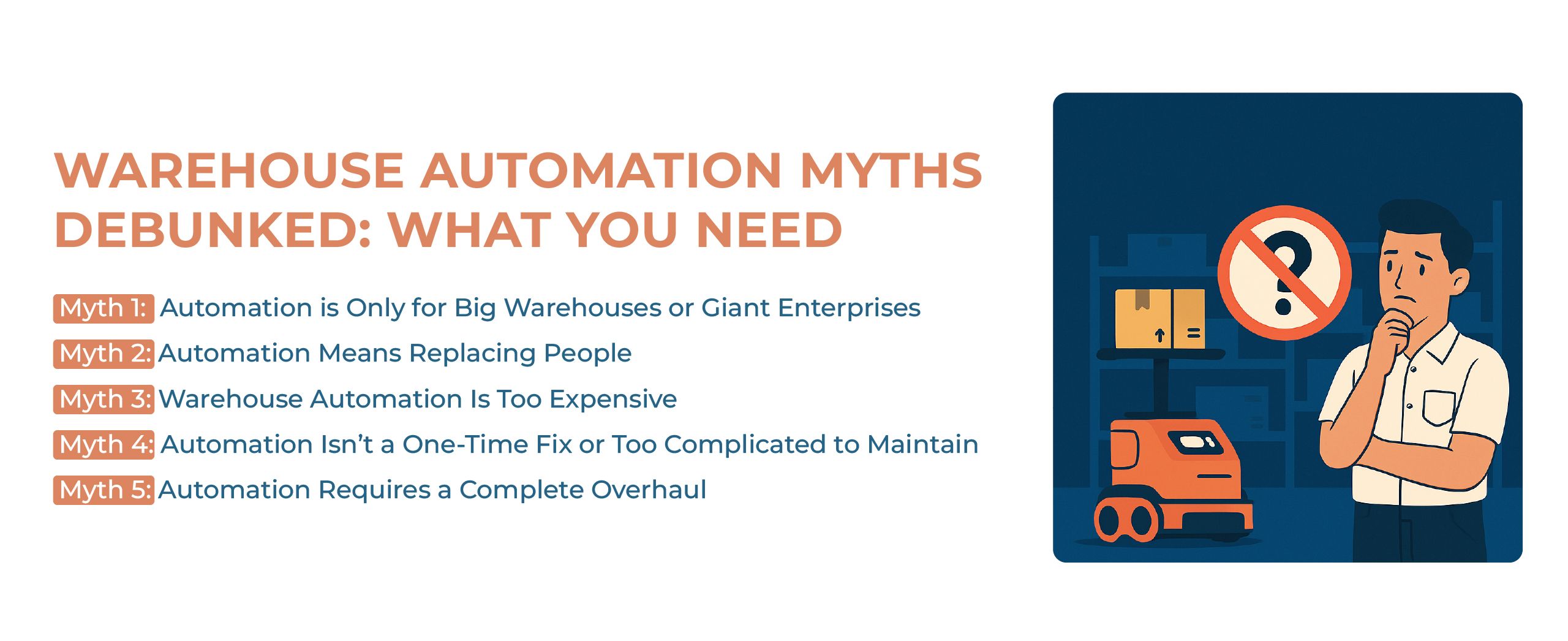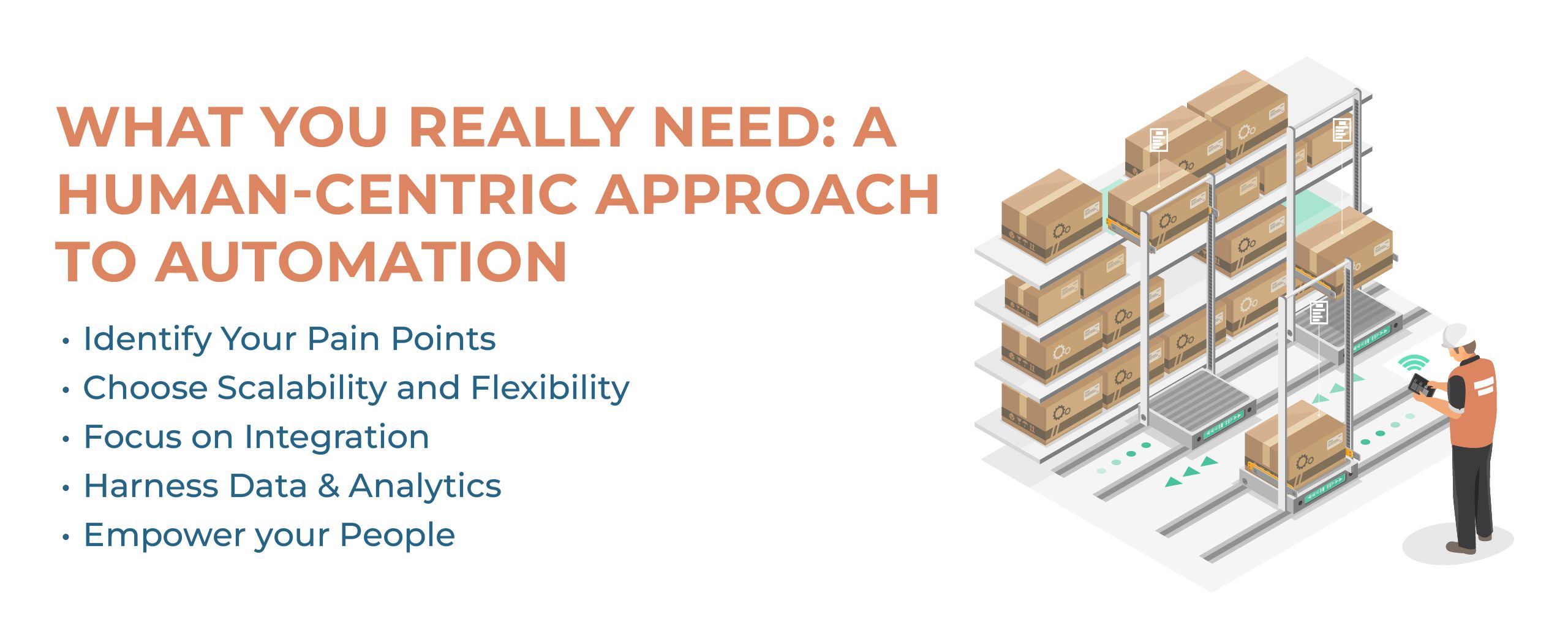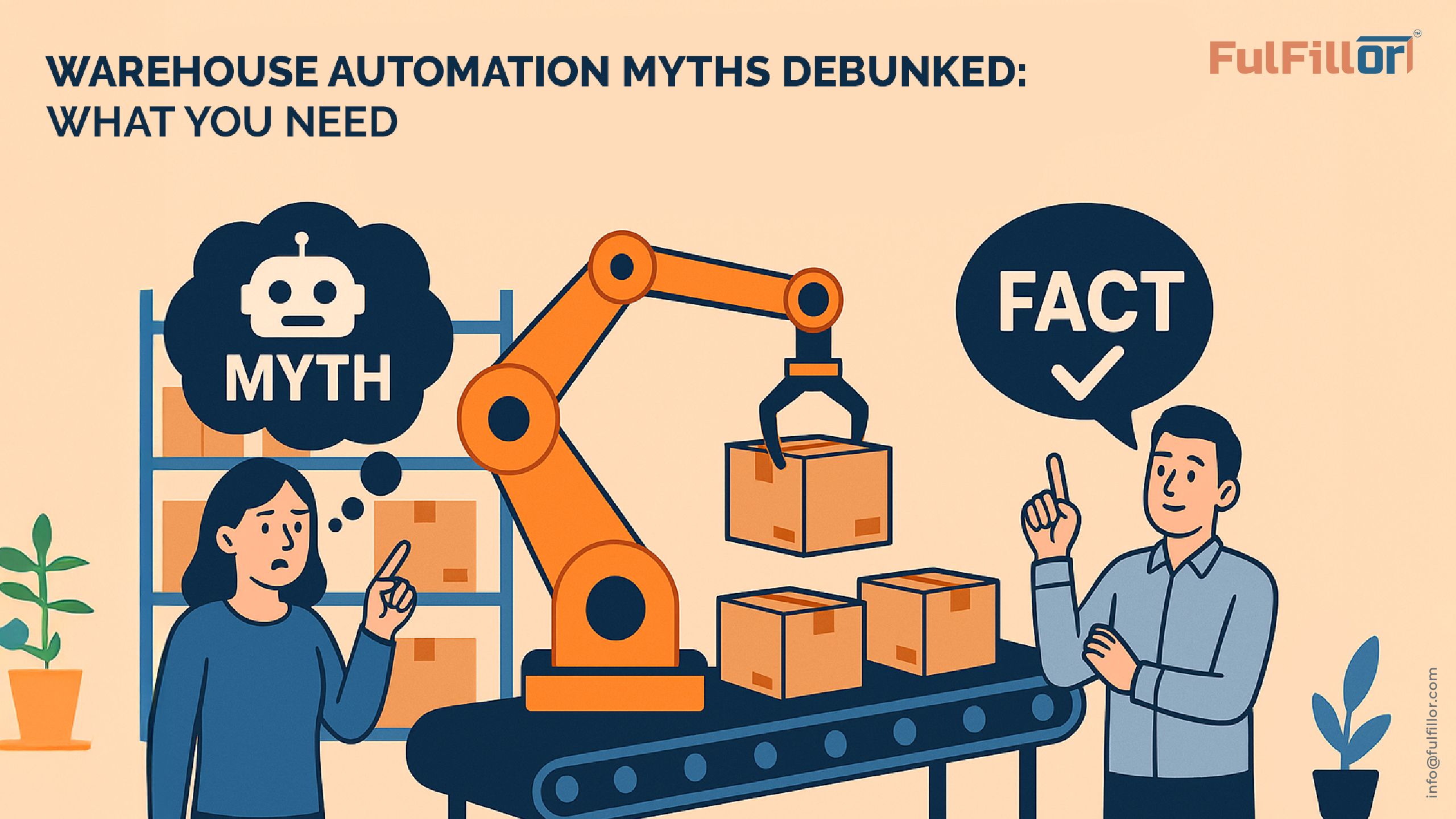Warehouse Automation Myths Debunked: What You Need
Warehouse automation is becoming increasingly important as supply chain challenges and labor shortages continue to impact operations. Automation is actively being considered by most warehouses to enhance precision and efficiency. But even with the rising attention, around 80% of warehouses globally are still rooted in manual operations.
This leads to a critical question: if there are well-documented advantages to automation, why have many businesses still not switched to automation? In many cases, the answer lies in misconceptions and fears around expense, complexity, and rollout.
The following blog aims to clarify many of the warehouse automation myths and to provide practical, honest guidance on the actual benefits and requirements for your operation to thrive.
In this blog, we’ll dive deep into these warehouse automation myths and some clear, actionable insights to cut through the confusion and help to understand the ultimate warehouse automation facts.
Warehouse Automation Myths Debunked: What You Need

Myth 1: Automation is Only for Big Warehouses or Giant Enterprises
A lot of people think that warehouse automation can only be afforded by major corporations, but this simply isn’t the case. Modern solutions, like Autonomous Mobile Robots (AMRs), Warehouse Management Systems (WMS), and Automated Guided Vehicles (AGVs), all offer scalable options, regardless of the size or scope of your business. For example, Fulfillor is a cloud-based WMS for 3PLs and e-commerce for businesses of every size, enabling smaller warehouses to implement order picks and inventory tracking with minimal upfront investment. You don’t have to be a giant enterprise or an MNC to win. Even a few AGVs, or a simple pick-to-light system, can make a huge difference in the efficiency and accuracy of your business.
Myth 2: Automation Means Replacing People
Warehouse automation isn’t a matter of slashing jobs and replacing people with robots; it’s about moving jobs and relocating them in a way that makes the lives of your team easier and safer. AS/RS systems and robotics will take care of the repetitive, menial labor, so your staff can do higher-value work like quality control, troubleshooting, and customer interaction. Automation rarely puts people out of work and takes away your job; rather, it tends to create jobs in different, sometimes more specialized, roles, such as maintenance people, programmers, and data analysts. Automation is it's all about empowering your people to work smarter and more efficiently, not replacing them, but enhancing what they can do.
Myth 3: Warehouse Automation Is Too Expensive
While the initial costs of automation can be expensive, long-term savings are substantial. Automation lowers labor costs, decreases errors, and increases throughput. In addition, there are mis-picks, inventory errors, and shipping delays, all because of manual processes. Modern, modular solutions such as AS/RS and Fulfillor WMS enable you to start small and expand as you grow, so you only pay for what you use. Advanced cost-effective tools such as barcode systems, conveyor belts, and cloud-based WMS can provide substantial operational benefits without a significant upfront capital investment. Automation can help you avoid expensive mistakes, optimize your space, and postpone your costly expansions, all with strong ROI over the longer term. The long-term savings and productivity increases far surpass the initial investment, so automation is a wise, scalable option for any warehouse.
Myth 4: Automation Isn’t a One-Time Fix or Too Complicated to Maintain
Today’s warehouse automation isn’t a set-it-and-forget-it solution. Today’s systems come with user-friendly options, with vendors offering setup, training, and service that keep operations running smoothly, no huge IT team required. Many cloud-based tools have automatic updates and maintenance. But like a car that must be maintained with oil changes and tune-ups, automation needs regular attention and optimization to truly drive value. As your business evolves, so should the strategy around automation. Advanced WMS (Warehouse Management Systems) and WES (Warehouse Execution Systems) give you the ability to adjust, measure performance, and adjust as per your business needs. Automation is not a one-time fix; it’s a journey. With consistent updates and regular maintenance, you can get the best results.
Myth 5: Automation Requires a Complete Overhaul
You don’t have to tear down your current warehouse to automate. The smartest strategy is to roll out in stages. Begin with some basics, such as warehouse management system (WMS) software or bar-code scanning, then scale up to automated storage and retrieval systems (AS/RS) or autonomous mobile robots (AMRs) as your needs change. Most modern options are made to work alongside your existing setup, so you can test, optimize, and grow without completely overhauling your business. This step-by-step approach minimizes risk, reduces costs, and allows your team to adapt slowly. If you automate in stages, you capture immediate efficiencies and can gradually improve your operations for future success, rather than requiring a complete overhaul.
What You Really Need: A Human-Centric Approach to Automation
So, what do you actually require for warehouse automation success? Here’s what matters most:

-
Identify Your Pain Points: Identify and eliminate your biggest headaches to start, whether it is picking errors, slow order processing, or labor shortages. The automation software best suited for a company focuses on true operational issues, rather than simply upgrading technology.
-
Choose Scalability and Flexibility: Look for systems that grow with you. For instance, Fulfillor allows you to start with simple inventory and order management, and add robotics or advanced shipping tools as you grow. It’s like having a system that evolves with you.
-
Focus on Integration: Your warehouse must integrate well with e-commerce, ERP, and shipping. Tight integration (such as the 150+ options of FulFillor’s) helps keep your data flowing, reducing errors.
-
Harness Data & Analytics: Use the power of real-time insight to identify trends, fix inefficiency, and make smart decisions. It’s like having a data-savvy assistant right there with you.
-
Empower your People: Automation should elevate your team, not replace them. Invest in learning, encourage new skills, and let your employees be champions of change. That’s the real secret of success.
Final Thoughts
Warehouse automation is no longer a myth; it's a reality that is changing the way we perceive and execute warehouse operations in modern times. You can bust myths and learn facts here to help inform how you can approach automation solutions that suit your needs.
No matter who you are, whether a warehouse manager, logistics professional, or supply chain exec, whether a small enterprise or a large company, warehouse automation tools like FulFillor will increase your productivity, lower your costs, and make your customers happier. FulFillor's intelligent Warehouse Management System is designed with 150+ integrations and real-time tracking, enabling you to control inventory, automate order fulfillment, and scale as your business grows.
Are you ready to take your first step toward smarter automation? Request a demo of FulFillor’s WMS to learn how automation can streamline fulfillment, enhance order accuracy, and keep you ahead in this competitive world.

